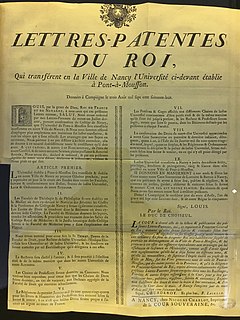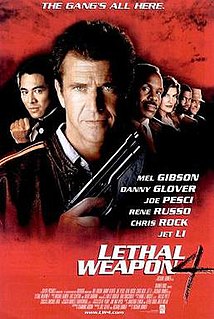Related Research Articles
In music theory, the term minor scale refers to three scale patterns – the natural minor scale, the harmonic minor scale, and the melodic minor scale – rather than just one as with the major scale.

A patent is a form of intellectual property that gives its owner the legal right to exclude others from making, using, or selling an invention for a limited period of years in exchange for publishing an enabling public disclosure of the invention. In most countries, patent rights fall under private law and the patent holder must sue someone infringing the patent in order to enforce his or her rights. In some industries patents are an essential form of competitive advantage; in others they are irrelevant.

Letters patent are a type of legal instrument in the form of a published written order issued by a monarch, president, or other head of state, generally granting an office, right, monopoly, title, or status to a person or corporation. Letters patent can be used for the creation of corporations or government offices, or for the granting of city status or a coat of arms. Letters patent are issued for the appointment of representatives of the Crown, such as governors and governors-general of Commonwealth realms, as well as appointing a Royal Commission. In the United Kingdom they are also issued for the creation of peers of the realm. A particular form of letters patent has evolved into the modern patent granting exclusive rights in an invention. In this case it is essential that the written grant should be in the form of a public document so other inventors can consult it to avoid infringement and also to understand how to "practice" the invention, i.e., put it into practical use. In the Holy Roman Empire, Austrian Empire, and Austria-Hungary, imperial patent was also the highest form of generally binding legal regulations, e. g. Patent of Toleration, Serfdom Patent etc.

The telautograph, an analog precursor to the modern fax machine, transmits electrical impulses recorded by potentiometers at the sending station to servomechanisms attached to a pen at the receiving station, thus reproducing at the receiving station a drawing or signature made by the sender. It was the first such device to transmit drawings to a stationary sheet of paper; previous inventions in Europe had used rotating drums to make such transmissions.

Elisha Gray was an American electrical engineer who co-founded the Western Electric Manufacturing Company. Gray is best known for his development of a telephone prototype in 1876 in Highland Park, Illinois. Some recent authors have argued that Gray should be considered the true inventor of the telephone because Alexander Graham Bell allegedly stole the idea of the liquid transmitter from him. Although Gray had been using liquid transmitters in his telephone experiments for more than two years previously, Bell's telephone patent was upheld in numerous court decisions.
Triadic may refer to:

Lethal Weapon 4 is a 1998 American buddy cop action comedy film directed and produced by Richard Donner, and starring Mel Gibson, Danny Glover, Joe Pesci, Rene Russo, Chris Rock, and Jet Li. It is the fourth and most recent instalment in the Lethal Weapon film series.
A patent attorney is an attorney who has the specialized qualifications necessary for representing clients in obtaining patents and acting in all matters and procedures relating to patent law and practice, such as filing an opposition. The term is used differently in different countries, and thus may or may not require the same legal qualifications as a general legal practitioner.
The Trilateral Patent Offices, or simply the Trilateral Offices, are the European Patent Office (EPO), the Japan Patent Office (JPO) and the United States Patent and Trademark Office (USPTO). In 1983, these patent offices set up a programme of co-operation in an effort to "improve efficiency of the global patent system".
A land patent is an exclusive land grant made by a sovereign entity with respect to a particular tract of land. To make such a grant "patent", a sovereign must document the land grant, securely sign and seal the document (patent), and openly publish the documents for the public to see. An official land patent is the highest evidence of right, title, and interest to a defined area. It is usually granted by a central, federal, or state government to an individual or to a private company.

In the United States, a design patent is a form of legal protection granted to the ornamental design of a functional item. Design patents are a type of industrial design right. Ornamental designs of jewelry, furniture, beverage containers and computer icons are examples of objects that are covered by design patents.
A patent family is "a set of patents taken in various countries to protect a single invention ." In other words, a patent family is "the same invention disclosed by a common inventor(s) and patented in more than one country." Patent families can be regarded as a "fortuitous by-product of the concept of priorities for patent applications".
Under United States law, a patent is a right granted to the inventor of a (1) process, machine, article of manufacture, or composition of matter, (2) that is new, useful, and non-obvious. A patent is the right to exclude others, for a limited time from profiting of a patented technology without the consent of the patent-holder. Specifically, it is the right to exclude others from: making, using, selling, offering for sale, importing, inducing others to infringe, applying for an FDA approval, and/or offering a product specially adapted for practice of the patent.

A catalytic triad is a set of three coordinated amino acids that can be found in the active site of some enzymes. Catalytic triads are most commonly found in hydrolase and transferase enzymes. An Acid-Base-Nucleophile triad is a common motif for generating a nucleophilic residue for covalent catalysis. The residues form a charge-relay network to polarise and activate the nucleophile, which attacks the substrate, forming a covalent intermediate which is then hydrolysed to release the product and regenerate free enzyme. The nucleophile is most commonly a serine or cysteine amino acid, but occasionally threonine or even selenocysteine. The 3D structure of the enzyme brings together the triad residues in a precise orientation, even though they may be far apart in the sequence.

George William Hart is an American geometer. He is an interdepartmental research professor at the State University of New York in Stony Brook, New York and his work includes both academic and artistic approaches to mathematics.

Google Patents is a search engine from Google that indexes patents and patent applications.

Push is a 2009 American superhero film directed by Paul McGuigan and written by David Bourla. Starring Chris Evans, Dakota Fanning, Camilla Belle, and Djimon Hounsou, the film centers on a group of people born with various superhuman abilities who band together in order to take down a government agency that is using a dangerous drug to enhance their powers in hopes of creating an army of super soldiers.
A patent application or patent may contain drawings, also called patent drawings, illustrating the invention, some of its embodiments, or the prior art. The drawings may be required by the law to be in a particular form, and the requirements may vary depending on the jurisdiction.
A triad is a Chinese transnational organized crime syndicate based in Greater China and has outposts in various countries with significant overseas Chinese populations.
The following outline is provided as an overview of and topical guide to patents:
References
- ↑ OECD (2005), Main Science and Technology Indicators, Vol. 1.
| This legal term article is a stub. You can help Wikipedia by expanding it. |